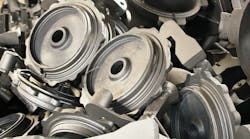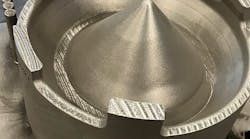Agrati AEE Die Casting Machines introduced a redesigned cold-chamber diecasting machine recently, with a new electronics package and control functions based on users’ requests. The critical design change was adopting Profinet industrial control platform over the Profibus fieldbus, for real-time data transmission at up to 100 Mbits/sec.
The machine builder emphasizes that changes in automation architecture have been, and will continue to be, a critical factor in equipment design, as it creates the possibility of maintaining centralized electronic control for an entire organization. Agrati was one of the first machine builders to adopt the concept of decentralized electronics, and now aims to be a leader in future developments in industrial automation.
This is important for the machines’ operators, Agrati stresses, because it makes possible some particular improvements, e.g., speeding up “system feedback” during critical periods, like the transition from slow to fast injection. But, there are also new advantages.
For example, the control graphics are improved with a new Windows XP/Vista interface, and “thematic” navigation system (e.g., die, machine, Input/Output, peripheral devices, utilities, Help, etc.)
Another practical improvement is a simplified procedure for installing peripheral devices, specifically robots, lubricators and a furnace or ladle. For each of these peripherals, the Agrati control architecture is simplified to a single page of settings displaying the relevant inputs and outputs. In practice, this means it’s no longer necessary to navigate from one page to another in order to find inputs, outputs, and the various settings, so start-up times for peripheral devices is reduced and (in case of malfunction) the diagnostic phase is simplified.
Also improved is data management, in particular the methods for accessing process and performance data, so that it’s possible to check machine settings remotely from a desktop, and to back-up data. Thus, it’s possible for large or small organizations to manage performance data using various network structures.
Machine controls are managed using a SmartCard reader, and each machine is supplied with five cards, each with a different level of access/authorization. “Cards range from Level 1, which allows a user to manage some simple operations, to Level 4, which oversees all machine settings,” according to Agrati. All access to the machine, and every program change, is recorded, so it’s possible to know who has modified any production parameter at any time.
In terms of machine diagnostics, the software pages concerning digital inputs and outputs of the machine peripherals have been redesigned. It’s simpler now to navigate through the peripheral diagnostics, and a new digital oscilloscope makes it possible to manage desired inputs and outputs. Also, a new Help function makes all the machine manuals (software, mechanical, and electrical/hydraulic schemes) visible to the operator.
As for the diecasting process, the control software performs a high-frequency sampling survey of the positions of the injection piston, with no risk of losing data thanks to an internal buffer. Reports concerning quality control and the related injection curves are saved in an Access database, so operators and managers can reference the reports through the LAN at any time and transfer data into a spreadsheet.
Reports are data-rich, including a new page that makes it possible to visualize all the main technical features of the press, and the pressure-carrying capacity scheme related to the machine and to the die. The technician/user can insert data concerning the piece and the die, and the system will suggest the (theoretical) best settings of the press.
The operator’s display will graph the desired working area for the piece being produced. Once the injection is made, it is possible to see whether or not the carrying capacity and pressure values measured by the quality control fall within the working area, and to identify immediately whether or not some parameter modification is necessary.










